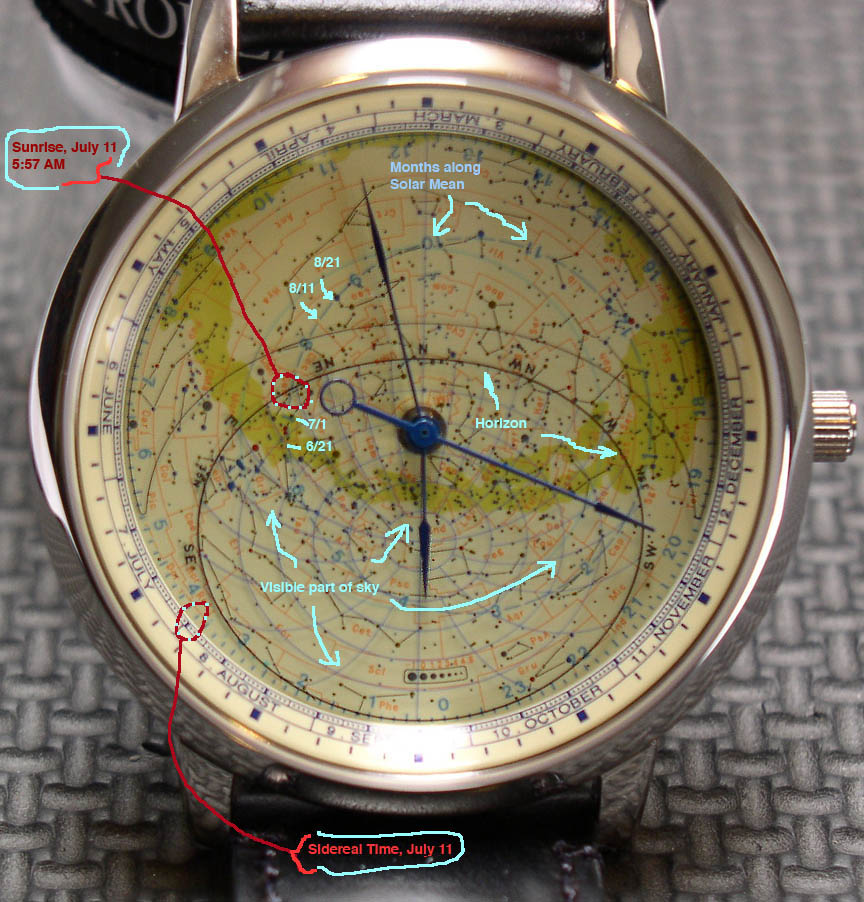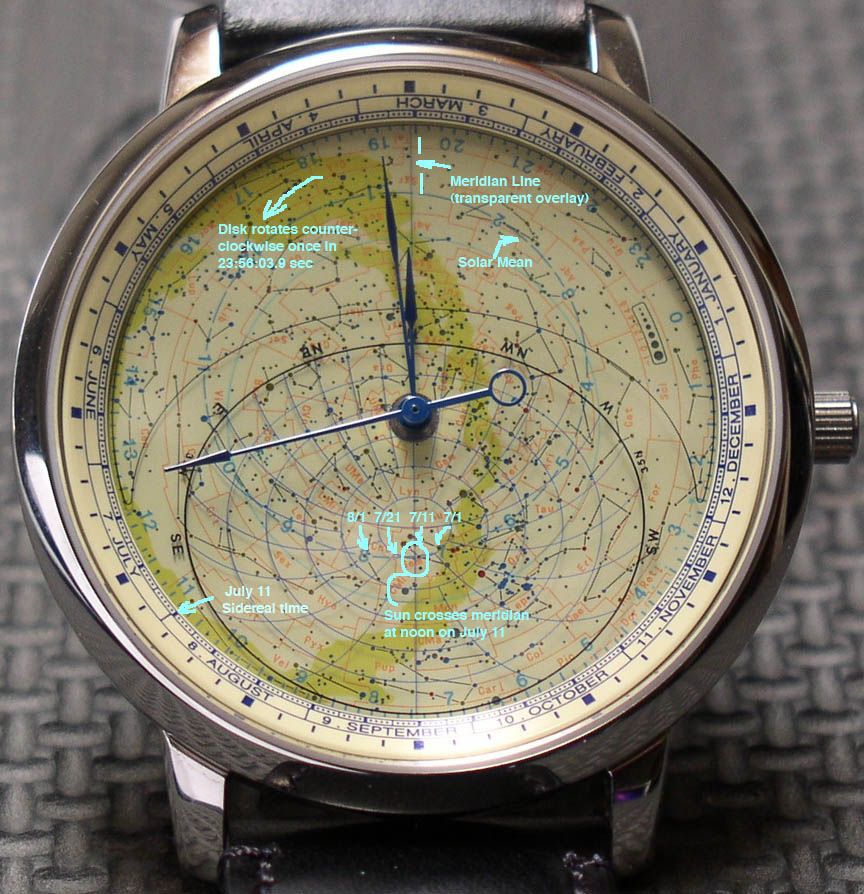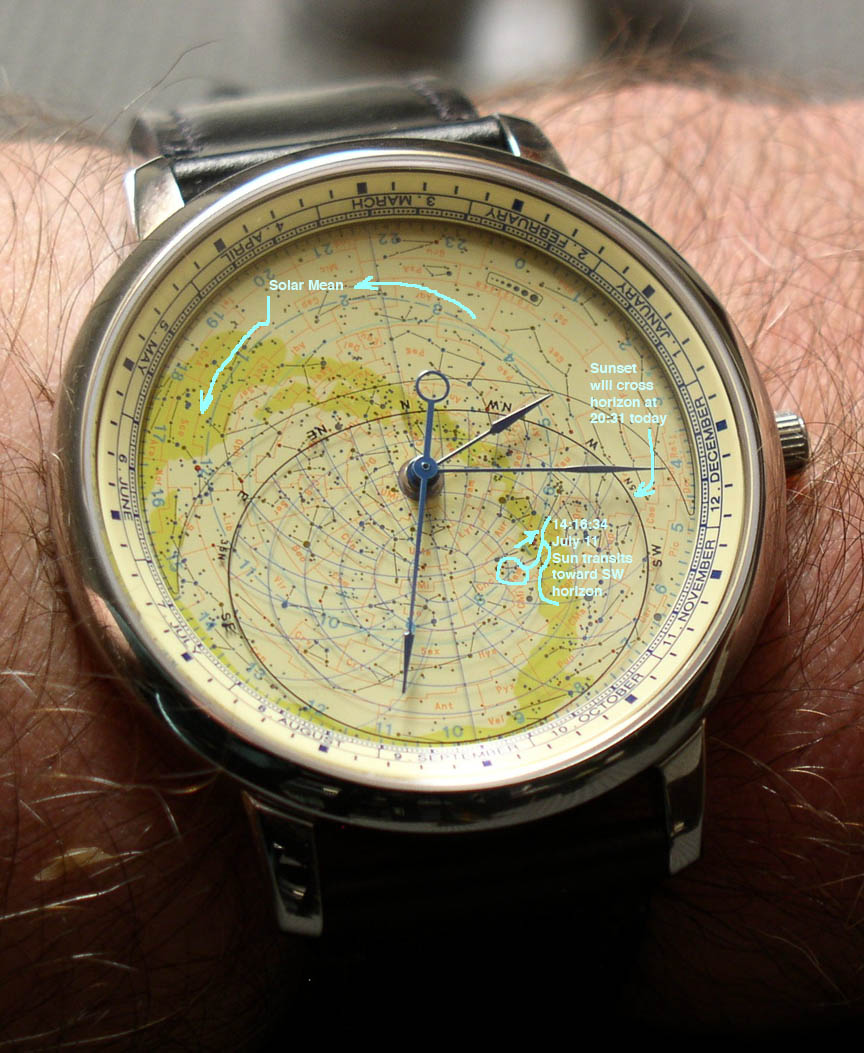skywatch
Citizen Astrodea - Review & Tips for setting a rare and unusual watch
by , Sep 4, 2015 at 08:24 PM (25552 Views)
I figured I would start my first IWL blog here with an article I wrote back in 2011, reviewing a watch I had searched for and finally found at a good price back at the time. I still have the watch in 2015, and stupid though it may sound, sometimes I have to go back and re-read this article to remember how to calibrate the star chart. So, let's put it here on IWL, just in case anyone finds one of these and needs a reminder. All the best - Robert
=================
Of all the watches that caught my attention over the years, none quite had the mystery surrounding them like the Citizen Astrodea. When I first joined a watch forum, I even chose the moniker "skywatch" because I love astronomical complications like this. I waited for several years before buying one, in part because I was hoping Citizen would come out with an Eco-drive version. I had decided I don't want more battery powered watches. (I also waited because it seemed rather expensive for a quartz watch.)
When I learned a bit more about the watch, I realized that the need for clarity on the rotating printed metal dial would make it hard to use the translucent plastic found on solar watches, and the dial's constant rotation would prevent electrical attachment if it were attached to a solar cell. When I searched the various watch forums for more information about the Astrodea's technical specifications, I couldn't find good clear information about setting or reading the beautiful chart on the dial.
I figured a novice review could help, for those few people who might be curious about this little instrument. I'll give a good short-cut and some explanation, without using all the astronomical terminology. I might have understood some of those terms 30 years ago, but I forgot enough that I needed to start from scratch to understand this thing.
=================
First impressions:
There are several versions of this watch, three latitudes (50°N, 35°N, 35°S), two sizes (38mm, 42mm) and two face colors (blue, yellow). I chose the 42mm yellow face for 35° north, a good match to my location at 37°N, in the San Francisco Bay area. The watch has sapphire crystal, on a low profile stainless case with a pop-top back to swap the silver oxide battery every 2-3 years.
The Astrodea arrived in its blue clamshell box, with pillow, Japanese instruction book, a 10x loupe, and additional English instructions provided by the USA eBay seller (www.watchdesign.com). It came on 22mm solid link bracelet, decent quality, but I promptly replaced the bracelet with a shell cordovan strap out of personal preference.
My initial impressions of the build quality were slightly mixed. No flaws, it just didn't quite have the "wow" factor in terms of materials, that the amazingly detailed face had led me to expect. It is rather lightweight, which I enjoy, but I realize I also like that subtle feeling of heft from a thicker-walled case. The star chart dial and the chapter ring are made from die-cut sheet metal, micro-printed with all the elements of an astronomy device. The resolution is impressive. However, the color of the face is basically light yellow, and I couldn't help but think of the Japanese metal robot toys from childhood. That metal robot association takes away some of the sense of a precision instrument.
Regarding the color, I like the yellow dial because it's much easier for me to read than the midnight blue dial. However, I think I prefer the over-all appearance of the dark blue. The constellation lines get lost on the dark blue background, while everything shows up very clearly on yellow. The yellow does not have the sophistication, though, it looks more like a scientific instrument and less like jewelry.
During my efforts to learn how to set the watch, I came to feel that it is not quite the precision instrument that its face implies. The star chart dial has a certain amount of mechanical play from the gear teeth, especially as it tracks the hour and minute hands when I change time manually. (I think for this reason the instructions often mention moving the hands past the desired point, then returning back, while setting.) The three position crown is quite small, and it sometimes shows strong resistance when clicking to the outer position to set the time. On the contrary, the middle click for setting the star chart is quite subtle, and often I am not sure if I have pulled it to the correct spot. Hopefully these movements will smooth out a bit with use.
These are minor quibbles from a perfectionist, though. The main attraction on the Astrodea is the incredibly detailed star chart on its dial, and its unusual ability to track sidereal time on the retrograde dial, alongside solar time.
================
A few definitions:
I had to remind myself of some terms before I could understand the instructions. I hope this review can fill a need for more simple basic instructions for the watch. I'll risk being less precise here, for added simplicity. Many thanks to Wikipedia, which provided some of the following, quoted or paraphrased (http://en.wikipedia.org/wiki/Sidereal_time)
Sidereal Time: measured relative to the stars rather than the sun. Because we turn once around the sun each year, that counts as one extra rotation relative to the stars, so we have 366 sidereal days in one year of 365 solar days. A sidereal day is approximately 23 hours, 56 minutes, 4.091 seconds
(23.93447 hours or 0.99726957 mean solar days.)
(Wiki further explains: A solar day is, therefore, nearly 4 minutes longer than a sidereal day. Because the Earth orbits the Sun once a year, the sidereal time at any one place at midnight will be about four minutes later each night, until, after a year has passed, one additional sidereal day has transpired compared to the number of solar days that have gone by.)
Meridian: In the sky, the meridian is an imaginary line going from north to south that goes through the point directly overhead, or the zenith. On the Citizen Astrodea, the meridian line goes vertically between 12 & 6 (it is located on the clear transparency that stays fixed while the star chart turns underneath it, counterclockwise, at sidereal time.)
Solar Mean: the line that the sun appears to trace as it "moves" through the sky.
================
The dial:
The face of the Astrodea shows the information defined above, along with over a thousand stars and major constellations, on three layers of the watch face. Of course, it's still a watch, so it has standard hour, minute and seconds hands. The hands do not have lume, unfortunately, but they have a nice teal blue color that shows up clearly on the gold dial. (The blue dial version has white-tipped hands, I do not know if they have lume on their tips.)
The uppermost portion of the dial is a fixed chapter ring around the outside edge, with squares marking the 12 hours, and small hatches for minutes, above the names and numbers for the twelve months. At the lower edge of this ring is a very finely divided track which marks the days of each month. Slightly thicker lines mark the days numbered 1,11,21.
The next layer down on the dial consists of a transparent overlay that does not move, showing: the vertical meridian line between 12 & 6; the oval horizon line at 35° latitude marked with directions of the compass; an outer ring marking the twilight hours when a glow still occurs after sunset or before sunrise; and declination lines going up to the zenith overhead (the sky-chart equivalent of longitude and latitude.) Inside of the horizon ring marks the visible sky, and outside of this ring marks the stars that are hidden behind the horizon.
(gearing for the watch face)
The main face of the dial shows the planisphere disk, and it moves in a counterclockwise direction, marking the sidereal day. It turns once every 23 hours, 56 minutes, 3.9 seconds (This would give a built-in error of about .2 seconds per day, probably limited by crystal oscillation rate and gear ratios, and is smaller error than the rated accuracy of the quartz movement at ±20 sec/month.) It moves counterclockwise because it shows the relative apparent motion of the sky opposite to the earth's clockwise rotation. This main dial has a huge amount of information packed onto it, including major constellations, visible objects 4.5 degrees of brightness and brighter, their different color types, and the sidereal hour markers around the edge. It also shows the solar mean disk marked with the numbers of the month. I found this solar display to be the easiest way to set the watch.
================
An easy way to set the star chart:
I must confess that I got a bit confused trying to understand the different approaches to using and setting the planisphere disk. Because it doesn't turn at the same rate as the 12 hour hands, it soon becomes clear that we need a calibrated start point, so the dates make sense along the edge as sidereal time slips earlier by 4 minutes each day. You can do this by calculating the longitude where you are standing, subtract 4 minutes per degree from 0° longitude (Greenwich) then find the correct settings for January 2 of the year. That gets really complicated.
I found a little gem hidden away in the technical manual for the Citizen 4391 watch caliber. It explains a short cut using the date markers on the Solar Mean disk and published sunrise information for your current location. Here are simple steps:
1) look up the sunrise time for your city, for today's date. Websites will show this, as will the weather page of a newspaper (remember those?)
2) Pull the crown all the way out, and set the hands to reflect the time of sunrise. In my example below I use July 11, 2011, with sunrise at 5:57 AM.
3) Look closely at the light blue Solar Mean disk, and you will see numbers from 1-12 corresponding to the months, and gaps in the line, between the month numbers, corresponding to dates 11 and 21.
4) Push the crown all the way back in, and then pull out slightly to the middle position to rotate the star disk. Rotate the disk counterclockwise until today's date on the Solar Mean lines up to the Eastern horizon line, corresponding to sunrise.
5) Pull the crown back out all the way to time-setting position, and back the minute hand up by about 20-30 minutes, then move the time forward again, back to sunrise (5:57 in the example.)
6) Check the solar mean to make sure it didn't slip after this time adjustment. Repeat the above procedure if it did slip. Once satisfied, move the time ahead to the current time on the same day.
You can see from the pictures below that once I set the correct sunrise time for my date, I can track the position of the sun from the watch dial by tracking the motion of today's date, on the Solar Mean disk, as the watch face turns. At noon, you can see that 7-11 (July 11) crosses the meridian line close to the zenith. Later, at around 2:15 in the afternoon, it has moved towards the southwest horizon, and it should cross the sunset line around 8:31 PM.
As the seasons progress, I will see these times change as the earth's position changes relative to the sun. In the meantime I can locate today's date on the outer chapter ring, and learn what the current sidereal time is relative to UTC. That would be useful if I wanted to calibrate a telescope, for example, or decide when to send a satellite into space.
I hope this didn't completely bore you. I thought a resource like this might prove helpful for those nutters like me who enjoy these sorts of toys.
All the best - Robert
=======================================
Some relevant calculations and terms:
Mountain View, CA
Latitude + Longitude
37° 23' 10" N / 122° 4' 58" W
Sidereal Calculation, +4min per degree east:
4x(122° 5') = 4x122.08 = 488.32 minutes = 8.138 hours (yes)
http://en.wikipedia.org/wiki/Sidereal_time
Sidereal day is approximately 23 hours, 56 minutes, 4.091 seconds
(23.93447 hours or 0.99726957 mean solar days)
corresponding to the time it takes for the Earth to complete one rotation relative to the vernal equinox.
A solar day is, therefore, nearly 4 minutes longer than a sidereal day:
Because the Earth orbits the Sun once a year, the sidereal time at any one place at midnight will be about four minutes later each night, until, after a year has passed, one additional sidereal day has transpired compared to the number of solar days that have gone by.
Maps of the stars in the night sky usually make use of declination and right ascension as coordinates. These correspond to latitude and longitude respectively. While declination is measured in degrees, right ascension is measured in units of hours and minutes. In the sky, the meridian is an imaginary line going from north to south that goes through the point directly overhead, or the zenith. Right ascension of any object currently crossing the meridian is equal to the current local (apparent) sidereal time.
===================================
Postscript: A good friend of mine who is an avid watch collector made these comments about my review, four years ago:
"A beautiful watch. But although I am a very serious amateur astronomer and thus attracted to this device, I had to admit to myself that I would not find its functionality attractive for astronomy.
Here's why.
1. The planisphere, while beautiful, is simply too small. Perhaps the 10x magnifier will ease that problem.
2. The way I use a planisphere is to check "what constellations are up at XX:XX o'clock". And XX:XX o'clock is almost never the current time. Rather it's next Friday night at 10:00 PM, or some other time in the future.
3. Obviously telling the time of day is a bit of a challenge.
Genuinely sorry indeed to be negative. Once again, it's truly beautiful. When Robert first told me it was inbound I wanted one too. I wrote to him, "Looks like something I should be interested in".
Sincerely,
Alan
===================================
And my reply to him remains relevant I think:
No need to worry about sounding critical, Alan. Your comments are well directed. Indeed the Astrodea has much more "cool factor" than it does practicality to an astronomer. But then, most could argue that dive watches were made obsolete by the dive computer, yet dive watches seem more popular than ever.
To address your 3 points: (1) Totally agree - the dial is very small for any practical use, although the loupe does help. In part, I think it's the miniaturization that makes the whole thing so cool.; (2) You can in fact use the planisphere for predictive viewing. You look up the sidereal time for the date you wish to view the sky, pull the crown out to the first step and rotate the sphere until the sidereal time lines up to the date of interest. Then, when done, you turn the disk back to the spot where it was before, corresponding to "now"; (3) It's actually quite easy to read the time. The hands are narrow, but show up very clearly on the dial, and the hour and minute markers are rather clear on the outside edge... but indeed there are no digits for the hours or minutes, and the date display is very tiny. Plus, using the date display assumes that you already know the date, and you use that info to line up the other functions. So, it's a different approach, certainly.
Thanks for contributing such thoughtful commentary! - Robert
===================================












 Email Blog Entry
Email Blog Entry

